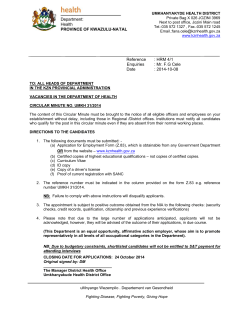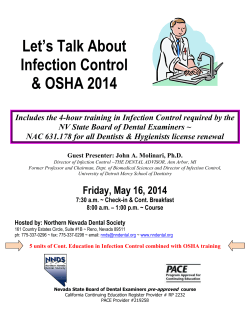
Low Back Pain and Sciatica
Low Back Pain and Sciatica Introduction Low back pain is an extremely common problem that is often poorly managed. Back pain is a particular challenge because it is so common, demanding of medical resources and a major cause of physical, psychological and social disability. Epidemiology • Back pain is extremely common, affecting 80%-90% of adult men and women between the ages of 30 and 50 years. • Back pain is second only to the common cold as a cause of lost days at work. What is back pain? • Most backache (85-90%) will be so-called simple low back pain (or 'mechanical low back pain') in which the symptoms by definition cannot be ascribed to a particular pathology (infection, tumour, osteoporosis, fracture, radicular syndrome, cauda equina syndrome (CES)). Simple low back ache is also called uncomplicated or non-specific low back pain and will vary with posture, activity, time and treatment. • Radicular (or nerve root pain) may occur with low back pain. Sciatica is a lay term for pain extending into the leg (buttock, thigh, calf or heel). • The classification into acute (less than 6 weeks), sub-acute (612 weeks) and chronic (more than 12 weeks) • Recurrent low back pain has been defined as a new episode of pain after a symptom-free period of 6 months.1 Causes • • • • Red flags may suggest spinal fracture, cancer, infection or serious pathology associated with prolapsed intervertebral disc. Other causes of back pain include: Primary malignancy: – Reticulo-endothelial system (myeloma is the most likely) – Carcinoma of pancreas – Osteosarcoma (does not usually affect the spine) Secondary cancers are usually from: – Bronchus – Breast – Prostate – Thyroid – Kidney Bone disorders including: – Paget's disease of bone (affects the pelvis in 72% of cases and the lumbar spine in 58%) – Osteoporosis (leading to vertebral collapse) – Spinal stenosis • • • • Inflammatory disease, for example: – Ankylosing spondylitis (AS) which tends to present: • Slowly in men under age 40 • With a rigid back • With aggravation by inactivity and relief with exercise – Psoriatic arthritis (rash or family history of psoriasis) – Reiter's syndrome (symptoms including urethritis) – Arthritis associated with inflammatory bowel disease (usually arthritis is peripheral) Infection: – Never forget tuberculosis (osteomyelitis can occur) – HIV predisposes to infections (including tuberculosis) – Renal tract infection (pyelonephritis can also cause referred back pain) Causes from outside the spinal column include: – Dissecting aortic aneurysm – A posterior duodenal ulcer presenting as back pain may be difficult to diagnose. If a gastric ulcer presents for the first time over the age of 40, malignancy needs to be excluded. – Nephrolithiasis – Pyelonephritis Factors suggesting malignancy include age greater than or equal to 50 years, previous history of cancer, duration of pain greater than 1 month, failure to improve with conservative therapy, elevated ESR, and anaemia.8 Consideration of these associations can reduce the number of fruitless back X-rays without missing malignancy. History What should the history include• • • • • • • • • When did the pain start? Was it sudden or gradual in onset? Where is it? Does it radiate anywhere else? Are there any aggravating or relieving factors? Has the patient had this problem before? Ask about occupation, what it involves and hobbies or sport. What does the patient think caused the pain? Note past medical history. Steroid use predisposes to osteoporosis. Has there been malignancy that metastasises to bone (lung, breast, prostate, thyroid, kidney) or myeloma? • How has the patient been managing the condition? This includes analgesics taken, whether they have been adequate and attitude to the condition. Red flags from history • • • • • • • • Red flags for possible serious spinal pathology from the history are Recent violent trauma (such as vehicle accident or fall from a height) Minor trauma, or even just strenuous lifting, in people with osteoporosis Age at onset less than 20 or over 50 years (new back pain) History of: – Cancer – Drug abuse – HIV – Immunosuppression – Prolonged use of corticosteroids Constitutional symptoms, e.g. fever, chills, unexplained weight loss Recent bacterial infection, e.g. urinary tract infection Pain that is: – Worse when supine – Severe at night time – Thoracic – Constant and progressive – Non-mechanical without relief from bed rest or postural modification – Unchanged despite treatment for 2-4 weeks – Accompanied by severe morning stiffness (rheumatoid arthritis and ankylosing spondylitis) – Severe and leaves patients unable to walk or self-care – Accompanied by saddle anaesthesia or recent onset of difficulty with bladder or bowels Examination • A brief examination for acute back pain is recommended with the patient undressed, revealing spine, and standing. • The brief examination should incorporate: inspection, palpation, brief neurological examination and an assessment of function. • More detailed neurological examination will be necessary if the history suggests any red flags, e.g. confirming saddle anaesthesia and diminished anal tone if CES is suspected. • Passive straight leg raising is often used to assist diagnosis of nerve root pain but it is highly sensitive (90%) and not very specific (20%).7 Red flags from examination • • • • • • • • • • • Structural deformity Severe or progressive neurological deficit in the lower extremities Unexpected laxity of the anal sphincter Perianal/perineal sensory loss Major motor weakness: knee extension, ankle plantar eversion, foot dorsiflexion Cauda equina syndrome should be suspected if: Bladder dysfunction (usually retention, sometimes overflow) Sphincter disturbance Saddle anaesthesia Lower limb weakness Gait disturbance Investigations • • Note: if the diagnosis would appear to be simple back pain, then no investigation is required. If other diagnoses are entertained, appropriate investigations are in order, depending upon the suspicion. • Imaging • • • X-rays- for fractures and osteoporosis CT-scan-spondylolisthesis MRI-soft tissues,disc and nerves. • Bloods • • • Full blood count, ESR, CRP, urine analysis if cancer, infection or inflammation suspected.9,10 LFTs may be helpful. Alkaline phosphatase can be elevated in metastatic disease and Paget's disease of bone. PSA will be raised particularly in carcinoma of the prostate. Management • Initially rest - perhaps with a board under the bed - was recommended for back pain. The new guidelines recommended active rehabilitation. The new principles of management involve keeping the patient active and giving analgesia to facilitate this. • Give information, reassurance and advice. • DO NOT prescribe bed rest. • Advise to stay as active as possible. • Prescribe regular pain relief (paracetamol, nonsteroidal anti-inflammatory drugs) and consider a short course of muscle relaxants. Other treatment options • acupuncture – fine needles are inserted into your skin at certain points on the body • exercise classes – aerobic exercise, muscle strengthening and stretching • manual therapy – your back is massaged or manipulated • Chiropractor and osteopaths. Referral guidance • If red flags suggest a serious condition, refer with appropriate urgency. This means immediately for CES. • If there is progressive, persistent or severe neurological deficit, refer for neurosurgical or orthopaedic assessment, preferably to be seen within 1 week. • If pain or disability remain problematic for more than a week or two, consider early referral for physiotherapy or other physical therapy. • If, after 6 weeks, sciatica is still disabling and distressing, refer for neurosurgical or orthopaedic assessment, preferably to be seen within 3 weeks. • If pain or disability continue to be a problem despite appropriate pharmacotherapy and physical therapy, consider referral to a multidisciplinary back pain service or a chronic pain clinic. Summary of referral guidance • These can also still be thought of usefully as 'immediate', 'urgent' and 'soon' referrals: • Immediately: – CES • Urgently: – Serious spinal pathology suspected – Progressive neurological deficit – Nerve root pain not resolving after 6 weeks • Soon: – Inflammatory conditions suspected, e.g. AS – Simple back pain and not resuming normal activities after 2-3 months
© Copyright 2025





















